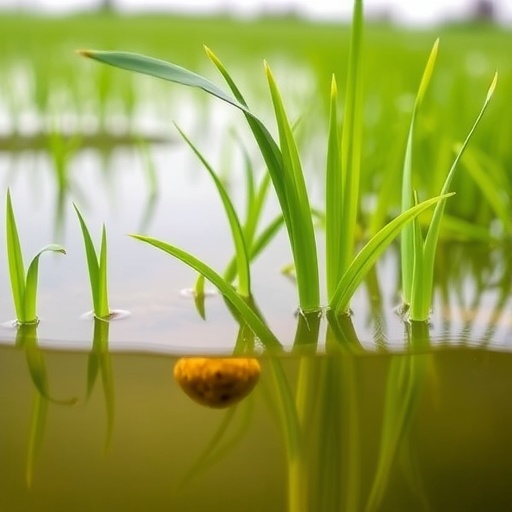In a groundbreaking study published in “Discover Plants,” researchers have unveiled significant insights into submergence tolerance in improved restorer lines of rice (Oryza sativa L.) seedlings. This research focuses on the evaluation of chlorophyll fluorescence and morphological responses in the face of varying durations of submergence, a critical factor that can influence the yield and viability of rice under flood-prone conditions. As climate change intensifies flooding events in agricultural regions, understanding the mechanisms behind submergence tolerance becomes increasingly vital.
The impetus for this research stems from the alarming frequency and intensity of flooding events globally. Rice, as a staple food for a large portion of the world’s population, is profoundly impacted by waterlogging and submergence. The study’s authors—Y. Manasa, P. Beulah, and G. Karthika—proposed that by improving the submergence tolerance of rice varieties, food security can be considerably enhanced, especially in regions that are susceptible to annual flooding. The findings from their research have the potential to revolutionize agricultural practices and breeding programs aimed at increasing rice resilience.
At the heart of the study is the measurement of chlorophyll fluorescence, which serves as a vital indicator of photosynthetic efficiency and plant health. Chlorophyll fluorescence measurements allow researchers to assess how well plants utilize light energy for photosynthesis, especially during stress conditions. The study meticulously details how improved restorer lines of rice seedlings respond to varying durations of submergence, with a focus on how chlorophyll fluorescence parameters change in response to this stressor. The methodology used provides a robust framework for evaluating the physiological performance of these improved rice lines.
In conducting their experiments, the researchers subjected the improved restorer lines to controlled flooding conditions for different durations. They measured key physiological parameters, including maximum quantum efficiency of photosystem II (Fv/Fm) and photochemical quenching (qP), both of which shed light on the plants’ ability to navigate submergence stress. Their observations illustrated stark differences among the various improved lines, indicating that some possess a superior ability to withstand prolonged flooding without a significant decline in photosynthetic function.
The morphological responses of the rice seedlings were equally compelling. The researchers documented changes in root architecture, leaf elongation, and overall plant height in response to submergence. These observations are crucial because they highlight adaptive traits that can be leveraged in breeding programs aimed at developing more resilient rice cultivars. The strategy of manipulating these traits through genetic improvement can ensure that rice varieties maintain productivity even in flood-prone environments, which is a growing concern in many agricultural regions worldwide.
Interestingly, the researchers noted that physiological and morphological adaptations often co-occur in plants facing similar stress conditions. This finding suggests that a multifaceted approach incorporating both physiological measurements and physical traits might provide a more complete picture of a plant’s resilience to stress. The integration of these different aspects of plant biology could lead to more effective breeding strategies and help identify which improvements yield the best results in terms of overall plant tolerance to submergence.
Moreover, the research hints at the genetic basis for these traits. By identifying specific markers associated with submergence tolerance, breeders could employ marker-assisted selection to expedite the development of new rice varieties. This would not only save time but also ensure a higher probability of success in breeding programs. As the challenges posed by climate change continue to escalate, the ability to breed crops that can withstand environmental extremes will be essential for sustainable agriculture.
The implications of the findings are far-reaching. With rice being a critical crop for food security in many developing nations, the insights gleaned from this study could inform agricultural policies and practices aimed at enhancing food production resilience in the face of climate change. Farmers equipped with resilient rice varieties would not only benefit their local economies but also contribute to global food security and stability.
As the research community continues to delve into the complexities of submergence tolerance, the importance of interdisciplinary collaboration becomes ever more apparent. Insights from physiology, genetics, agronomy, and environmental science must align to craft solutions that meet the needs of both farmers and ecosystems. This study serves as a prime example of how targeted research can yield practical solutions in a world grappling with the dual challenges of climate change and food security.
The methodology adopted in this research can be replicated for other crops facing similar challenges, producing a wealth of data that could inform global agricultural practices. Researchers around the world are likely to take notice of these findings and integrate them into their frameworks for studying plant tolerance mechanisms under water stress.
In conclusion, the work presented by Manasa et al. emphasizes a crucial area of agricultural research that holds promise not just for rice but for other staple crops affected by climate-induced challenges. The dual focus on both physiological traits and morphological responses enriches our understanding of plant resilience and sets the stage for future advancements in crop breeding. As we move forward, the lessons learned from this study will undoubtedly shape the next generation of climate-resilient agricultural systems.
Our understanding of plant responses to environmental challenges is constantly evolving. As researchers continue to explore the intricate details of plant responses, it is paramount to bridge the gap between scientific research and practical agricultural applications. The findings presented in this study will be instrumental in paving the way for more robust and resilient agricultural practices in an ever-changing world.
Subject of Research: Submergence tolerance in improved restorer lines of rice (Oryza sativa L.) seedlings.
Article Title: Unveiling submergence tolerance in improved restorer lines of rice (Oryza sativa L.) seedlings at varied durations: evaluation through chlorophyll fluorescence and morphological responses.
Article References: Manasa, Y., Beulah, P., Karthika, G. et al. Unveiling submergence tolerance in improved restorer lines of rice (Oryza sativa L.) seedlings at varied durations: evaluation through chlorophyll fluorescence and morphological responses.
Discover. Plants 2, 300 (2025). https://doi.org/10.1007/s44372-025-00382-2
Image Credits: AI Generated
DOI:
Keywords: Submergence tolerance, rice, chlorophyll fluorescence, morphological responses, flooding resilience, Oryza sativa.




